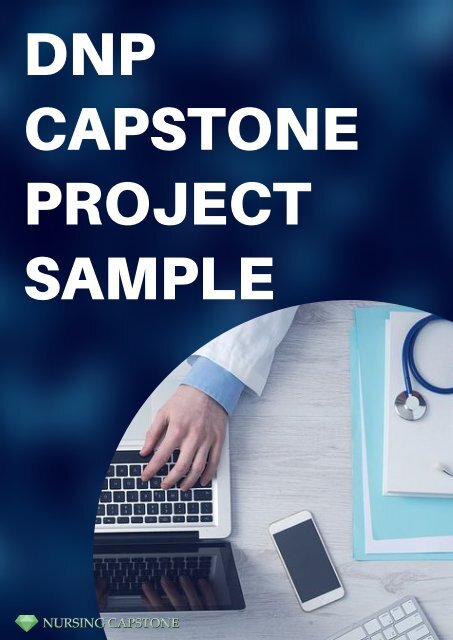DNP Capstone Project Sample
Hi! Look at this article with a DNP capstone project sample. For more visit https://www.nursingcapstone.net/our-dnp-capstone-projects-writing-services/
Hi! Look at this article with a DNP capstone project sample. For more visit https://www.nursingcapstone.net/our-dnp-capstone-projects-writing-services/
Create successful ePaper yourself
Turn your PDF publications into a flip-book with our unique Google optimized e-Paper software.
<strong>DNP</strong><br />
CAPSTONE<br />
PROJECT<br />
SAMPLE
Abstract<br />
Childhood Screening Among Patients of<br />
Adult Primary Care<br />
The increasing occurrences of Adverse Childhood Experiences (ACE) in<br />
the US has been estimated to affect 60 percent of the entire population.<br />
There is also a growing body of evidences unequivocally stating the impact<br />
of childhood adversity on the surfacing of chronic negative health<br />
outcomes (Schafer & Altaro, 2010). It has also been observed that the<br />
cumulative impacts of adverse childhood experiences also present some<br />
profound societal implications and public health impact. Despite this highly<br />
overwhelming evidence, it has been suggested by research that a lack of<br />
highly effective ACE screening is popular in the primary care setting.<br />
Dependable research evidences has further demonstration a connection<br />
in between experiencing childhood adversity, along with multiple negative<br />
chronic health conditions which are found to be prevalent in the adult<br />
primary care setting. Furthermore, managing chronic diseases also account<br />
for 86% of overall healthcare costs in the US (Greenfield & Alter, 2010).<br />
Purpose<br />
The aim of this project is to translate evidences of the negative influence<br />
of ACE on health, especially in the clinical practice. The ultimate purpose is<br />
to eliminate the existing gap between clinical practice and evidence-based<br />
ACE research.<br />
Methods<br />
In order to complete this project, a screening intervention which is<br />
designed to evaluate childhood adversity, along with the presence of<br />
various chronic diseases was further implemented among adult patients in<br />
the primary care setting. A chosen clinical site for the implementation was<br />
owned by a nurse practitioner, operating as a primary care office in a<br />
huge rural community.
Adult patients who have backgrounds of chronic pain, gastrointestinal<br />
complaints, anxiety, substance abuse, depression, as well as those with<br />
poorly managed chronic health condition were also screened for this<br />
condition (Edwards, Cook & Crook, 2011). Adult patients who are living in<br />
high-risk settings, or who previously had high health care utilization were<br />
screened as well.<br />
A post-screening form was also used and filled out by the nurse<br />
practitioner student in order to collect information regarding the<br />
screening process which include patient responses, comfort level,<br />
provider preparedness, as well as patient-specific recommendations for<br />
follow-up. Descriptive statistics were then used in calculating total<br />
number of adults screened, provider and patient responses, and the<br />
overall prevalence of ACEs.<br />
Results<br />
Out of the convenience sample presented, 82% have reported<br />
experiencing ACE. Despite a high prevalence, a total of 24% of the<br />
patients received psychological counseling. These chronic diseases were<br />
also found to be liked with higher ACE scores. On top of that, relevant<br />
reports of additional chronic health problems were also found to expand<br />
on those that are hypothesized originally.<br />
Moreover, the average screening time on ACE was 8.5 minutes. An<br />
increase in the comfort and knowledge of the provider left a strong<br />
positive correlation along with a decrease in ACE screening time. Also,<br />
providers which were more secure in ability and knowledge to screen for<br />
ACE were more comfortable.<br />
Conclusion<br />
The huge volume of individuals who had to deal with poorly managed<br />
chronic illnesses observed in the primary care setting makes it possible<br />
for identifying ACE. On top of that, ACE is also linked with other chronic<br />
diseases usually unrecognized by providers and patients.
The evaluation of this ACE screening also suggests that ACE screening is<br />
highly feasible in the primary care setting, thus allowing for the<br />
improvement of patient outcomes through purposeful interventions. Also,<br />
increasing comfort and knowledge in ACE screening is also shown to<br />
help providers and patients to improve their well-being further, while<br />
showing effectiveness in the management of chronic diseases.<br />
References<br />
Edwards, T., Cook, W. & Crook, P. (2011). Adverse childhood experiences<br />
during adulthood and adolescence. American Medical Association<br />
Journal, 34(2), 1234-1345.<br />
Greenfield, Y. & Alter, J. (2010). Prevention and Health Promotion for<br />
Chronic Disease, Retrieved on February 2, 2014 from<br />
http://www.cdc.up/chronic/index/24235.html.<br />
Schafer, E. & Altaro, B. (2010). Adverse Childhood Experiences Reports.<br />
Weekly Medical Report, 23(3), 12-13.<br />
WE HAVE PROFESSIONALS WHO<br />
SPECIALIZE IN PROFESSIONAL <strong>DNP</strong><br />
CAPSTONE PROJECTS WRITING SO<br />
CONTACT US NOW!















